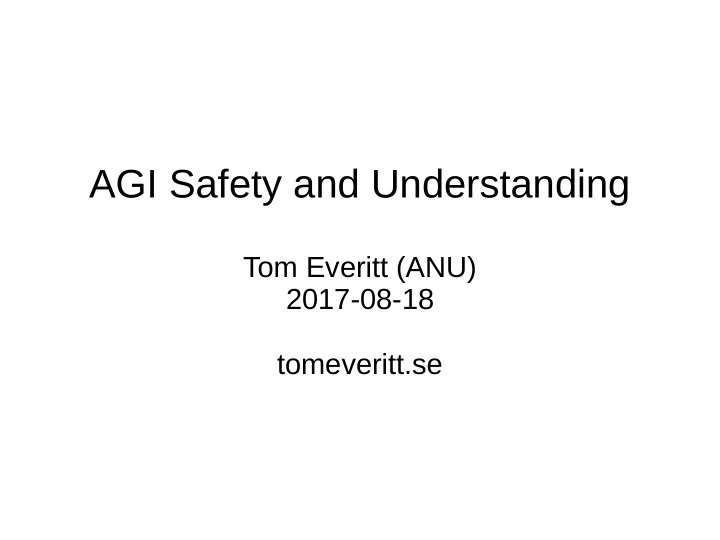

AGI Safety and Understanding Tom Everitt (ANU) 2017-08-18 tomeveritt.se
AGI Safety “How can we control something that is smarter than ourselves?” ● Key problems: – Value Loading / Value Learning – Corrigibility – Self-preservation https://www.scientificamerican.com/article/skeptic-agenticity/
Value Loading ● Teach AI relevant high level concepts – Human – Happiness – Moral rules (requires understanding) ● Define goal in these terms: “ Maximise human happiness subject to moral constraints ”
The Evil Genie Effect ● Goal: Cure Cancer! King Midas ● AI-generated plan: 1. Make lots of money by beating humans at stock market predictions 2. Solve a few genetic engineering challenges 3. Synthesize a supervirus that wipes out the human species 4. No more cancer https://anentrepreneurswords.files.wordpress.com/2014/06/king-midas.jpg => Explicit goal specification bad idea
Value Learning http://www.markstivers.com/wordpress/?p=955
Reinforcement Learning (AIXI, Q-learning, ...) ● Requires no understanding ● Some problems: – Hard to program reward function – Laborious to give reward manually – Catastrophic exploration – Wireheading http://diysolarpanelsv.com/man-jumping-off-a-cliff-clipart.html
RL Extensions 1: Human Preferences ● Learn reward function from human preferences ● Recent OpenAI/ Google DeepMind paper – Show human short video clips ● Understanding required: – How communicate scenarios to human? What are the salient features? – Which scenarios are possible / plausible / relevant?
RL Extensions 2 (Cooperative) Inverse Reinforcement Learning ● Learn reward function from human actions – Actions are preference statements ● Helicopter flight (Abbeel et al, 2006) ● Understanding required: – Detect action (cf. soccer kick, Bitcoin purchase) – Infer desire from action
Limited oversight ● Inverse RL: – No oversight required (in theory) ● Learning from Human Preferences: – more data-efficient than RL if queries well-chosen
Catastrophic exploration ● RL: “Let’s try!” ● Human Preferences: “Hey Human, should I try?” ● Inverse RL: “What did the human do?”
Wireheading ● RL: Each state is “self-estimating” its reward ● Human Pref. and Inv. RL: Wireheaded states can be “verified” from outside ● (Everitt et. al., IJCAI-17)
Corrigibility ● Agent should allow for software corrections and shut down ● Until recently, considered separate problem (Hadfield-Menell et al., 2016; Wangberg et al., AGI-17 ) Human pressing shutdown button is a – strong preference statement/ – easily interpretable action that the AI should shut down now
Self-Preservation (of values, corrigibility, software, hardware, ...) ● Everitt et al., AGI-16: (some) agents naturally want to self-preserve ● Need understanding of self ● Self-understanding? – AIXI, Q-learning (Off-policy RL) – SARSA, Policy Gradient (On-policy RL) – Cognitive architectures
Summary ● Understand – Concepts => specify goals => EVIL GENIE – Ask and interpret preferences => RL from Human Preferences – Identify and and interpret human actions => Inverse RL – Self-understanding ● Properties – Limited oversight – Safe(r) exploration – Less/no wireheading – Corrigibility – Self-preservation
References ● Deep Reinforcement Learning from Human Preferences. Christiano et al. , NIPS 2017. ● Reinforcement Learning from a Corrupted Reward Channel. Everitt et al. IJCAI, 2017. ● Trial without Error: Towards Safe Reinforcement Learning via Human Intervention. Saunders et al. Arxiv, 2017. ● Cooperative Inverse Reinforcement Learning. Hadfield-Menell et al. NIPS, 2016 ● The Off-Switch Game. Hadfield-Menell et al. Arxiv, 2016. ● A Game-Theoretic Analysis of the Off-Switch Game. Wangberg et al. , AGI 2017. ● Self-Modification of Policy and Utility Function in Rational Agents. Everitt et al., AGI 2016. ● Superintelligence: Paths, Dangers, Strategies. Bostrom , 2014. ● An Application of Reinforcement Learning to Aerobatic Helicopter Flight. Abbeel et al., NIPS, 2006.
Recommend
More recommend